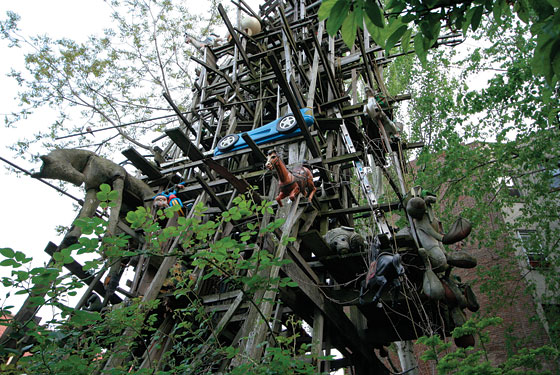
In the eighties, I lived three buildings down from where Eddie Boros—a scruffy, bearded, shoeless neighborhood character who seemed vaguely scary but who never did anything that actually scared me—built what came to be called the “Tower of Toys” at the corner of East 6th Street and Avenue B. I often saw Eddie in the Yemeni grocery, where he’d buy individual cigarettes or cans of tuna. He was a fixture in a neighborhood of human fixtures, a reminder that the East Village was still marginal, where odd things were normal and normalcy was odd.
At some point, Boros, who passed away last year, began carrying wooden planks, closet poles, religious statuary, and stuffed animals to the plot. At first, it was just another ugly pile of stuff in the East Village. Whatever. Then something started happening. A rectangular wooden base formed. Then it grew. You’d see him put a plank in place and leave. Then he’d come back and put another in place. Sometimes he’d work for days on end, rain, snow, or shine. Often he was barefoot. Other times he’d disappear for weeks. He worked by some unknowable circadian rhythm.
Slowly the tower grew. There seemed to be no order to it whatsoever. All it did was get higher and more piecemeal. He’d climb up the structure like some acrobatic bear and work away. I’d hoped I was witnessing the birth of an extraordinary East Coast version of Simon Rodia’s visionary Watts Towers in L.A. But ultimately it became apparent that Boros didn’t have that kind of sense of fantasy, form, material, or color. He just had a sense of height and a feel for wood.
It wasn’t beautiful, but it was beautifully eccentric, part of a folk-art tradition put together from the detritus and wreckage of once-raggedy neighborhoods by individuals working on the edge of society. Adam Purple’s glorious “Garden of Eden” on Eldridge Street was torn down in 1986; the metal-sculpture garden on Avenue B and East 2nd was evicted in 1995. And last week, the Tower of Toys came down. All of these projects, and others elsewhere in the city, served as demarcation lines, stopgaps against encroaching gentrification. Now there aren’t any peripheries in Manhattan, and there are few anywhere in the city. Everything has a price. Everything except outsider eccentricity, which evidently is bad for business.
Have good intel? Send tips to [email protected].